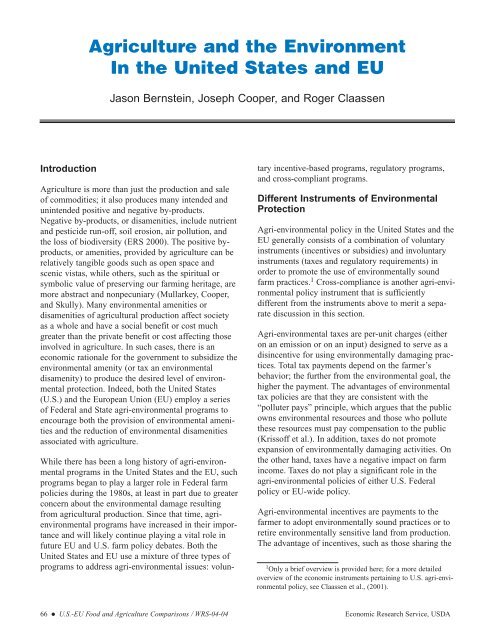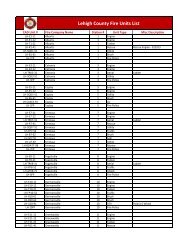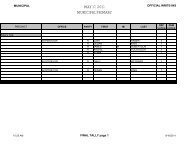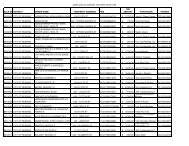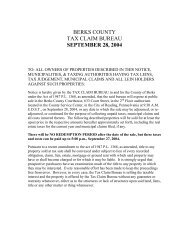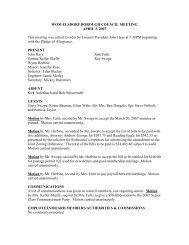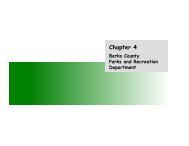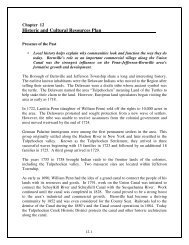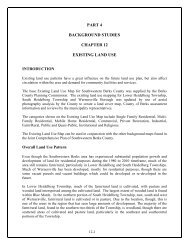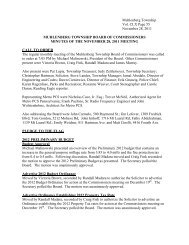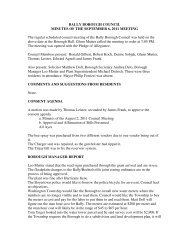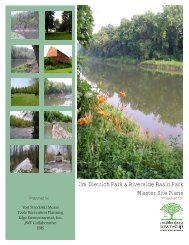Agriculture and the Environment In the United States and EU
Agriculture and the Environment In the United States and EU
Agriculture and the Environment In the United States and EU
Create successful ePaper yourself
Turn your PDF publications into a flip-book with our unique Google optimized e-Paper software.
<strong>In</strong>troduction<br />
<strong>Agriculture</strong> <strong>and</strong> <strong>the</strong> <strong>Environment</strong><br />
<strong>In</strong> <strong>the</strong> <strong>United</strong> <strong>States</strong> <strong>and</strong> <strong>EU</strong><br />
Jason Bernstein, Joseph Cooper, <strong>and</strong> Roger Claassen<br />
<strong>Agriculture</strong> is more than just <strong>the</strong> production <strong>and</strong> sale<br />
of commodities; it also produces many intended <strong>and</strong><br />
unintended positive <strong>and</strong> negative by-products.<br />
Negative by-products, or disamenities, include nutrient<br />
<strong>and</strong> pesticide run-off, soil erosion, air pollution, <strong>and</strong><br />
<strong>the</strong> loss of biodiversity (ERS 2000). The positive byproducts,<br />
or amenities, provided by agriculture can be<br />
relatively tangible goods such as open space <strong>and</strong><br />
scenic vistas, while o<strong>the</strong>rs, such as <strong>the</strong> spiritual or<br />
symbolic value of preserving our farming heritage, are<br />
more abstract <strong>and</strong> nonpecuniary (Mullarkey, Cooper,<br />
<strong>and</strong> Skully). Many environmental amenities or<br />
disamenities of agricultural production affect society<br />
as a whole <strong>and</strong> have a social benefit or cost much<br />
greater than <strong>the</strong> private benefit or cost affecting those<br />
involved in agriculture. <strong>In</strong> such cases, <strong>the</strong>re is an<br />
economic rationale for <strong>the</strong> government to subsidize <strong>the</strong><br />
environmental amenity (or tax an environmental<br />
disamenity) to produce <strong>the</strong> desired level of environmental<br />
protection. <strong>In</strong>deed, both <strong>the</strong> <strong>United</strong> <strong>States</strong><br />
(U.S.) <strong>and</strong> <strong>the</strong> European Union (<strong>EU</strong>) employ a series<br />
of Federal <strong>and</strong> State agri-environmental programs to<br />
encourage both <strong>the</strong> provision of environmental amenities<br />
<strong>and</strong> <strong>the</strong> reduction of environmental disamenities<br />
associated with agriculture.<br />
While <strong>the</strong>re has been a long history of agri-environmental<br />
programs in <strong>the</strong> <strong>United</strong> <strong>States</strong> <strong>and</strong> <strong>the</strong> <strong>EU</strong>, such<br />
programs began to play a larger role in Federal farm<br />
policies during <strong>the</strong> 1980s, at least in part due to greater<br />
concern about <strong>the</strong> environmental damage resulting<br />
from agricultural production. Since that time, agrienvironmental<br />
programs have increased in <strong>the</strong>ir importance<br />
<strong>and</strong> will likely continue playing a vital role in<br />
future <strong>EU</strong> <strong>and</strong> U.S. farm policy debates. Both <strong>the</strong><br />
<strong>United</strong> <strong>States</strong> <strong>and</strong> <strong>EU</strong> use a mixture of three types of<br />
programs to address agri-environmental issues: volun-<br />
tary incentive-based programs, regulatory programs,<br />
<strong>and</strong> cross-compliant programs.<br />
Different <strong>In</strong>struments of <strong>Environment</strong>al<br />
Protection<br />
Agri-environmental policy in <strong>the</strong> <strong>United</strong> <strong>States</strong> <strong>and</strong> <strong>the</strong><br />
<strong>EU</strong> generally consists of a combination of voluntary<br />
instruments (incentives or subsidies) <strong>and</strong> involuntary<br />
instruments (taxes <strong>and</strong> regulatory requirements) in<br />
order to promote <strong>the</strong> use of environmentally sound<br />
farm practices. 1 Cross-compliance is ano<strong>the</strong>r agri-environmental<br />
policy instrument that is sufficiently<br />
different from <strong>the</strong> instruments above to merit a separate<br />
discussion in this section.<br />
Agri-environmental taxes are per-unit charges (ei<strong>the</strong>r<br />
on an emission or on an input) designed to serve as a<br />
disincentive for using environmentally damaging practices.<br />
Total tax payments depend on <strong>the</strong> farmer’s<br />
behavior; <strong>the</strong> fur<strong>the</strong>r from <strong>the</strong> environmental goal, <strong>the</strong><br />
higher <strong>the</strong> payment. The advantages of environmental<br />
tax policies are that <strong>the</strong>y are consistent with <strong>the</strong><br />
“polluter pays” principle, which argues that <strong>the</strong> public<br />
owns environmental resources <strong>and</strong> those who pollute<br />
<strong>the</strong>se resources must pay compensation to <strong>the</strong> public<br />
(Krissoff et al.). <strong>In</strong> addition, taxes do not promote<br />
expansion of environmentally damaging activities. On<br />
<strong>the</strong> o<strong>the</strong>r h<strong>and</strong>, taxes have a negative impact on farm<br />
income. Taxes do not play a significant role in <strong>the</strong><br />
agri-environmental policies of ei<strong>the</strong>r U.S. Federal<br />
policy or <strong>EU</strong>-wide policy.<br />
Agri-environmental incentives are payments to <strong>the</strong><br />
farmer to adopt environmentally sound practices or to<br />
retire environmentally sensitive l<strong>and</strong> from production.<br />
The advantage of incentives, such as those sharing <strong>the</strong><br />
1 Only a brief overview is provided here; for a more detailed<br />
overview of <strong>the</strong> economic instruments pertaining to U.S. agri-environmental<br />
policy, see Claassen et al., (2001).<br />
66 � U.S.-<strong>EU</strong> Food <strong>and</strong> <strong>Agriculture</strong> Comparisons / WRS-04-04 Economic Research Service, USDA
costs of adoption of environmentally benign management<br />
practices or paying farmers to set aside l<strong>and</strong>, is<br />
that <strong>the</strong>y increase <strong>the</strong> likelihood that farmers will<br />
adopt <strong>the</strong> desired practices or retire l<strong>and</strong>. The disadvantage<br />
of incentives is that achieving desired levels of<br />
adoption of environmentally benign management practices<br />
or of l<strong>and</strong> retirement with <strong>the</strong>m may be costly for<br />
taxpayers. <strong>In</strong>centives can also have <strong>the</strong> effect of<br />
exp<strong>and</strong>ing production by <strong>the</strong> farm, or increasing entry<br />
into <strong>the</strong> sector, so even if <strong>the</strong> disamenities produced by<br />
each farm (or on each field) decrease, more farms (or<br />
fields) now produce disamenities. 2<br />
Regulatory requirements, or st<strong>and</strong>ards, represent involuntary<br />
(or m<strong>and</strong>atory) participation approaches that<br />
establish st<strong>and</strong>ards that all targeted actors must adhere<br />
to. The ban on <strong>the</strong> production <strong>and</strong> application of <strong>the</strong><br />
chemical DDT is one such example. Unlike policy<br />
choices in which farmer participation is uncertain, regulations<br />
simply require that all farmers participate. This<br />
feature is particularly important if <strong>the</strong> consequences of<br />
not changing practices are drastic or irreversible. On <strong>the</strong><br />
o<strong>the</strong>r h<strong>and</strong>, regulatory requirements are a blunt tool <strong>and</strong><br />
can be <strong>the</strong> least flexible of all policy instruments,<br />
requiring that producers reach a specific environmental<br />
goal or adopt specific practices. Producers are not free<br />
to determine <strong>the</strong>ir own level of participation, based on<br />
<strong>the</strong>ir costs. Unless regulators know farm-specific costs<br />
(which is unlikely) <strong>and</strong> can use this information to<br />
establish farm-specific regulations, agri-environmental<br />
effort is not necessarily directed toward producers who<br />
can make changes (achieve gains) at <strong>the</strong> lowest cost.<br />
Consequently, regulation can be less flexible <strong>and</strong> less<br />
efficient than economic incentives such as taxes <strong>and</strong><br />
subsidies. Regulatory requirements receive less prominence<br />
than o<strong>the</strong>r instruments within traditional agrienvironmental<br />
policy in both <strong>the</strong> <strong>EU</strong> <strong>and</strong> <strong>the</strong> <strong>United</strong><br />
<strong>States</strong>, but <strong>the</strong> regulatory environment is becoming<br />
increasingly complex.<br />
Cross-compliance requires a basic level of environmental<br />
compliance as a condition for farmer eligibility<br />
for o<strong>the</strong>r government programs that farmers may find<br />
economically desirable, such as those that provide<br />
producer payments. Technically, cross-compliance is a<br />
voluntary, indirect incentives-based instrument, but as<br />
2 According to Baumol <strong>and</strong> Oates, a firm that would be unprofitable<br />
under a tax may be made profitable by an incentive (subsidy).<br />
While a tax may drive a firm out of a competitive industry<br />
<strong>and</strong> so generally lead to a decrease in its output, an incentive may<br />
increase entry <strong>and</strong> induce expansion in competitive outputs.<br />
it represents a st<strong>and</strong>ard for receiving a subsidy, in<br />
practice it may not strictly be perceived as voluntary,<br />
particularly when <strong>the</strong> existing subsidy represents an<br />
important share of total farm income. It may be difficult<br />
for a farmer to forego cross-compliance when <strong>the</strong><br />
value of <strong>the</strong> existing subsidies exceed <strong>the</strong> farmer’s<br />
costs of adopting <strong>the</strong> m<strong>and</strong>ated practices. 3 <strong>In</strong> this<br />
circumstance, loss of <strong>the</strong>se payments is dramatically<br />
different from foregoing an additional subsidy that is<br />
offered as compensation for adopting conservation<br />
practices. An advantage of cross-compliant programs<br />
is that less government outlay is required than with<br />
subsidies to address environmental problems.<br />
Disadvantages are that it will have lower capacity for<br />
impact on farms that are not traditional clients of<br />
Federal farm payment programs or in situations when<br />
program payments are low. 4 Also, <strong>the</strong> administration<br />
of cross-compliance programs may require intergovernmental<br />
coordination of programs with divergent<br />
goals.<br />
While some agri-environmental instruments tend to be<br />
more cost-effective than o<strong>the</strong>rs in producing environmental<br />
benefits, <strong>the</strong> cost-effectiveness of any specific<br />
program depends greatly on <strong>the</strong> details of implementation.<br />
5 For example, significant variation in climate, soils,<br />
crops, <strong>and</strong> proximity to environmental resource (e.g.,<br />
rivers or lakes) means that <strong>the</strong> ability to produce environmental<br />
benefits (or reduce environmental damage) can<br />
vary widely among farms, particularly in a national<br />
program. Highly erodible soils, located near a major<br />
river in an area of high rainfall intensity, are likely to<br />
deliver significantly more sediment to <strong>the</strong> river than less<br />
erodible l<strong>and</strong> located far<strong>the</strong>r from <strong>the</strong> river or in an area<br />
3<strong>In</strong> recent years, government payments have accounted for a<br />
large share of farm income, particularly in grain-producing <strong>States</strong>.<br />
Moreover, farm commodity programs have been in place for sufficient<br />
lengths of time in both <strong>the</strong> <strong>EU</strong> <strong>and</strong> <strong>the</strong> <strong>United</strong> <strong>States</strong>--more<br />
than 65 years in <strong>the</strong> <strong>United</strong> <strong>States</strong>--that payments are largely capitalized<br />
into <strong>the</strong> value of l<strong>and</strong> (Barnard et al., 1997; Duffy et al.,<br />
1994) <strong>and</strong> are generally built into producers’ financial calculations.<br />
For many producers, <strong>the</strong> ability to purchase l<strong>and</strong> or pay cash rent<br />
depends significantly on farm program payments.<br />
4Cross-compliance requires levels of monitoring <strong>and</strong> enforcement<br />
that are adequate to ensure environmental compliance. Of<br />
course, <strong>the</strong> o<strong>the</strong>r programs discussed here may also require monitoring<br />
<strong>and</strong> enforcement to ensure that <strong>the</strong> farmers adopt <strong>the</strong> desired<br />
practices. However, <strong>the</strong> costs of monitoring <strong>and</strong> compliance may<br />
vary across types of programs. For instance, l<strong>and</strong> retirement may<br />
be easier to verify than adoption of particular farm management<br />
practices.<br />
5See Claassen et al., (2001) for a more detailed discussion of<br />
<strong>the</strong>se issues.<br />
Economic Research Service, USDA U.S.-<strong>EU</strong> Food <strong>and</strong> <strong>Agriculture</strong> Comparisons / WRS-04-04 � 67
of lower rainfall intensity. The cost-effectiveness of<br />
specific policy instruments can vary widely depending<br />
on <strong>the</strong> extent to which this type of variation is recognized<br />
<strong>and</strong> accommodated within <strong>the</strong> program. This <strong>and</strong><br />
o<strong>the</strong>r potential variations in implementation (e.g., <strong>the</strong><br />
level of flexibility accorded producers) make it difficult<br />
to rank <strong>the</strong> cost-effectiveness of instruments irrespective<br />
of o<strong>the</strong>r program details.<br />
<strong>In</strong> practice, however, both <strong>the</strong> <strong>United</strong> <strong>States</strong> <strong>and</strong> <strong>EU</strong> use<br />
environmental programs to support farm prices, incomes,<br />
or both, as well as increase environmental amenities or<br />
reduce pollution. Agri-environmental policies often have<br />
<strong>the</strong> dual objective of environmental protection <strong>and</strong> farm<br />
income support, at least implicitly. The fact that some<br />
agri-environmental policies are trying to fulfill <strong>the</strong> twin<br />
objectives, in part, explains <strong>the</strong>ir structure.<br />
U.S. Agri-environmental Policy<br />
“U.S. Agri-<strong>Environment</strong>al Programs” lists major U.S.<br />
agri-environmental policies (ERS, 2000; Claassen et<br />
al., 2001). Nearly all agri-environmental programs<br />
authorized under <strong>the</strong> 1996 FAIR Act were continued<br />
<strong>and</strong> many received large funding increases in <strong>the</strong> 2002<br />
Farm Act. Several major new programs were also<br />
established. Overall, conservation funding is slated to<br />
increase by 80 percent with <strong>the</strong> 2002 farm bill. 6<br />
Major U.S. agri-environmental programs can be categorized<br />
as ei<strong>the</strong>r incentive programs or cross-compliance<br />
mechanisms. <strong>Environment</strong>al incentive programs<br />
can be fur<strong>the</strong>r categorized.<br />
L<strong>and</strong> retirement programs remove l<strong>and</strong> from crop<br />
production. <strong>In</strong> exchange for retiring l<strong>and</strong>, producers<br />
receive rental or easement payments plus cost sharing<br />
<strong>and</strong> technical assistance to aid in <strong>the</strong> establishment<br />
of permanent cover. Economic use of <strong>the</strong> l<strong>and</strong><br />
is limited.<br />
Working l<strong>and</strong> conservation programs support<br />
adoption <strong>and</strong> maintenance of l<strong>and</strong> management <strong>and</strong><br />
structural conservation practices on agricultural<br />
l<strong>and</strong>, including cropl<strong>and</strong>, grazing l<strong>and</strong>, <strong>and</strong> in some<br />
cases, forestl<strong>and</strong>, in exchange for cost-shares or<br />
incentives.<br />
Agricultural l<strong>and</strong> preservation programs help<br />
retain l<strong>and</strong> in agricultural production by purchasing<br />
<strong>the</strong> right to convert l<strong>and</strong> to o<strong>the</strong>r uses.<br />
6See ERS (2002) for more details on policy changes in <strong>the</strong><br />
2002 Act.<br />
Finally, a number of regulatory programs affect agriculture,<br />
but are generally originated outside of <strong>the</strong><br />
House <strong>and</strong> Senate <strong>Agriculture</strong> Committees in Congress<br />
<strong>and</strong> are primarily concerned with non-agricultural<br />
industries. For a discussion of regulatory programs in<br />
agri-environmental policy see Claassen et al., (2001).<br />
L<strong>and</strong> Retirement. The Conservation Reserve Program<br />
(CRP) offers annual payments <strong>and</strong> cost sharing to<br />
establish long-term, resource-conserving cover on<br />
environmentally sensitive l<strong>and</strong>. Contracts are for 10 to<br />
15 years. Economic use of <strong>the</strong> l<strong>and</strong> is limited during<br />
<strong>the</strong> contract period, but l<strong>and</strong>owners retain <strong>the</strong> right to<br />
return l<strong>and</strong> to crop production at <strong>the</strong> end of <strong>the</strong><br />
contract. The Wetl<strong>and</strong>s Reserve Program (WRP)<br />
provides cost sharing <strong>and</strong> long-term or permanent<br />
easements for restoration of wetl<strong>and</strong>s on agricultural<br />
l<strong>and</strong>. L<strong>and</strong>owners retain l<strong>and</strong> ownership <strong>and</strong> rights to<br />
recreational uses, such as hunting <strong>and</strong> fishing.<br />
L<strong>and</strong> retirement has dominated Federal agricultural<br />
conservation spending since 1985 (fig. 1). Roughly 50<br />
percent of all USDA conservation spending since 1985<br />
has been for l<strong>and</strong> retirement. About 10 percent of U.S.<br />
cropl<strong>and</strong>--nearly 35 million acres--is currently enrolled<br />
in a Federal l<strong>and</strong> retirement program, largely through<br />
CRP (33.8 million acres). The 2002 Act exp<strong>and</strong>s <strong>the</strong><br />
CRP acreage cap to 39.2 million acres, while <strong>the</strong> WRP<br />
acreage cap is more than doubled, from 1.075 to 2.275<br />
million acres.<br />
L<strong>and</strong> retirement programs have lowered U.S. agricultural<br />
production, resulting in higher prices for<br />
commodities such as wheat, corn, <strong>and</strong> soybeans.<br />
According to a study conducted by <strong>the</strong> Farm Service<br />
Agency (cited in ERS (2000), chapter 6.2), <strong>the</strong> combination<br />
of higher commodity prices <strong>and</strong> l<strong>and</strong> retirement<br />
payments have increased farmer income more than any<br />
loss of income due to non-production on unused l<strong>and</strong>.<br />
<strong>In</strong>creases in farm income have also exceeded <strong>the</strong><br />
increase in consumer expenditure due to higher<br />
commodity prices. L<strong>and</strong> retirement programs have<br />
been shown to have positive environmental effects on<br />
soil productivity, water quality, <strong>and</strong> air quality but<br />
<strong>the</strong>se effects are small compared with <strong>the</strong> effects on<br />
farm income <strong>and</strong> consumer expenditure (ibid). 7<br />
Besides <strong>the</strong>se impacts, l<strong>and</strong> retirement programs have<br />
<strong>the</strong> added benefit of being relatively easy to implement<br />
7 However, it should be noted that monetary values of only a<br />
subset of environmental impacts have been estimated.<br />
68 � U.S.-<strong>EU</strong> Food <strong>and</strong> <strong>Agriculture</strong> Comparisons / WRS-04-04 Economic Research Service, USDA
U.S. Agri-<strong>Environment</strong>al Programs (administered by <strong>the</strong> USDA) 1<br />
Voluntary Programs<br />
<strong>Environment</strong>al Quality <strong>In</strong>centives Program<br />
(EQIP)—Through use of technical assistance, education,<br />
cost-sharing, <strong>and</strong> incentive payments, EQIP assists farmers<br />
<strong>and</strong> ranchers in adopting l<strong>and</strong> management <strong>and</strong> structural<br />
practices that improve environmental performance.<br />
Conservation Security Program (CSP)—Provides payments<br />
to farmers in return for <strong>the</strong>ir use of a wide range<br />
of environmentally-benign l<strong>and</strong> management practices.<br />
The program has three “tiers” for participation; with<br />
higher tiers requiring greater conservation effort <strong>and</strong><br />
offering larger payments. Existing practices can be<br />
enrolled. This program is new under <strong>the</strong> 2002 Farm<br />
Bill.<br />
Wildlife Habitat <strong>In</strong>centives Program (WHIP)—Similar<br />
to EQIP but aims to protect wildlife habitats.<br />
Conservation Reserve Program (CRP)—Provides rental<br />
payments to agricultural producers who retire environmentally<br />
sensitive cropl<strong>and</strong> for 10 to 15 years.<br />
Wetl<strong>and</strong> Reserve Program (WRP)—Assists l<strong>and</strong>owners<br />
in restoring wetl<strong>and</strong>s on agricultural l<strong>and</strong> through easement<br />
payments <strong>and</strong> restoration cost sharing.<br />
Conservation Technical Assistance (CTA)—Provides<br />
technical assistance to farmers <strong>and</strong> ranchers who<br />
implement soil <strong>and</strong> water conservation <strong>and</strong> water quality<br />
improvement.<br />
Farml<strong>and</strong> Protection Program (FPP)—Allocates funds<br />
for purchase of conservation easements <strong>and</strong> o<strong>the</strong>r types<br />
of interest in l<strong>and</strong> with prime, unique, or o<strong>the</strong>r highly<br />
productive soils. The new version of FPP under <strong>the</strong><br />
2002 Farm Bill receives a 20-fold increase in funding<br />
<strong>and</strong> extends eligibility to l<strong>and</strong> with “historically important<br />
l<strong>and</strong> areas <strong>and</strong> structures.”<br />
1 For an in-depth description of U.S. agri-environmental programs<br />
<strong>and</strong> related expenditures, see ERS (2000) <strong>and</strong> ERS<br />
(2002).<br />
<strong>and</strong> enforce since l<strong>and</strong> retirement can be easily<br />
confirmed.<br />
Working L<strong>and</strong> Conservation. The <strong>Environment</strong>al<br />
Quality <strong>In</strong>centives Program (EQIP) provides technical<br />
assistance, cost sharing, <strong>and</strong> incentive payments to<br />
assist livestock <strong>and</strong> crop producers with adoption of a<br />
wide range of environmentally benign production<br />
Emergency Conservation Program (ECP)—Provides<br />
financial assistance to farmers who conserve water<br />
while recovering from natural disasters such as severe<br />
drought.<br />
Grassl<strong>and</strong> Reserve Program (GRP)—Using contracts<br />
or easements in conjunction with compensatory payments,<br />
up to 2 million acres of grassl<strong>and</strong> will be protected<br />
from conversion to o<strong>the</strong>r uses.<br />
Regulatory Programs2 Clean Water Act (CWA)—Operators may be subject to<br />
effluent discharge permits if CWA st<strong>and</strong>ards are not<br />
met.<br />
Federal <strong>In</strong>secticide, Fungicide <strong>and</strong> Rodenticide Act<br />
(FIFRA)—Uses restrictions <strong>and</strong> bans on certain pesticides.<br />
Endangered Species Act (ESA)—Under ESA, farmers<br />
may not “take a member” (e.g. reduce <strong>the</strong> population)<br />
of a listed species.<br />
Clean Air Act—The use of methyl bromide, a fumigant,<br />
is largely being phased out under this act.<br />
Cross-compliance Programs<br />
Conservation Compliance—<strong>In</strong>troduced in <strong>the</strong> 1985<br />
Farm Bill, conservation compliance requires conservation<br />
systems on previously cropped highly-erodible<br />
l<strong>and</strong> (HEL) as a condition of eligibility for certain Federal<br />
farm programs, including farm price <strong>and</strong> income<br />
support.<br />
Sodbuster—Producers who bring HEL into production<br />
must apply strict soil conservation systems to be eligible<br />
for farm programs.<br />
Swampbuster—Producers who covert wetl<strong>and</strong> for agricultural<br />
production can lose Federal farm program<br />
payments.<br />
2 These programs are not administered by <strong>the</strong> USDA.<br />
practices, or best management practices (BMPs). The<br />
Wildlife Habitat <strong>In</strong>centives Program (WHIP) provides<br />
cost sharing to l<strong>and</strong>owners <strong>and</strong> producers to develop<br />
<strong>and</strong> improve wildlife habitat. The new Conservation<br />
Security Program (CSP) will provide payments to<br />
producers for maintaining or adopting a wide range of<br />
structural <strong>and</strong> l<strong>and</strong> management practices that address<br />
a variety of local <strong>and</strong>/or national resource concerns.<br />
Economic Research Service, USDA U.S.-<strong>EU</strong> Food <strong>and</strong> <strong>Agriculture</strong> Comparisons / WRS-04-04 � 69
CSP could fund <strong>the</strong> installation <strong>and</strong>/or maintenance of<br />
<strong>the</strong> same types of practices funded under EQIP, with<br />
<strong>the</strong> notable exception of livestock waste h<strong>and</strong>ling <strong>and</strong><br />
storage facilities, which may be funded under EQIP,<br />
but not under CSP. Finally, USDA also provides<br />
conservation technical assistance (CTA) to producers<br />
who adopt agri-environmental BMPs outside of o<strong>the</strong>r<br />
USDA conservation programs.<br />
<strong>In</strong> <strong>the</strong> past, funding for working l<strong>and</strong> conservation<br />
has been modest in comparison with l<strong>and</strong> retirement<br />
(fig. 1-F). The 2002 Act provides a large increase in<br />
<strong>the</strong>se programs, relative to increases for l<strong>and</strong> retirement<br />
(fig. 2-F). EQIP is slated to receive $5.8 billion<br />
over <strong>the</strong> 6 years of <strong>the</strong> 2002 Farm Bill (2002-07), an<br />
average of $966 million per year, nearly five times<br />
<strong>the</strong> $200 million annual funding authorized by <strong>the</strong><br />
1996 FAIR Act. The CSP could receive up to $3.8<br />
billion over <strong>the</strong> next 10 years, although <strong>the</strong><br />
Congressional Budget Office (CBO) estimated that<br />
CSP will spend only $987 million through fiscal year<br />
2007 (<strong>the</strong> end of <strong>the</strong> 2002 Act).<br />
Because working l<strong>and</strong> programs are generally quite<br />
flexible when compared with l<strong>and</strong> retirement, this<br />
change in funding may lead to a broader array of<br />
options <strong>and</strong> greater flexibility for producers in<br />
meeting <strong>the</strong> requirements of <strong>the</strong> program. Namely,<br />
working l<strong>and</strong> programs may represent a large suite of<br />
management practices <strong>the</strong> farmer can choose from in<br />
building a conservation plan, while l<strong>and</strong> retirement<br />
essentially represents to <strong>the</strong> farmer a choice between<br />
keeping <strong>the</strong> l<strong>and</strong> in production or not. Greater flexibility<br />
allows producers to develop conservation<br />
strategies that are tailored to <strong>the</strong>ir own climate, soils,<br />
<strong>and</strong> management skills, potentially delivering agrienvironmental<br />
gains at a lower cost. <strong>In</strong> EQIP, for<br />
example, producers can choose from a wide range of<br />
conservation practices in developing a conservation<br />
plan. Plans can include both l<strong>and</strong> management practices<br />
such as nutrient management or conservation<br />
tillage <strong>and</strong> structural practices such as waste<br />
storage/h<strong>and</strong>ling systems, grass waterways, <strong>and</strong> filter<br />
strips. EQIP contracts can be as little as 1 year or as<br />
long as 10 years in length.<br />
Perhaps <strong>the</strong> biggest innovation of <strong>the</strong> 2002 Act is <strong>the</strong><br />
creation of <strong>the</strong> CSP. A key difference between this<br />
program <strong>and</strong> existing agri-environmental programs,<br />
such as EQIP, is that under CSP, agri-environmental<br />
payments for specific environmentally benign best<br />
management practices (BMPs) would be available to<br />
Figure 1-F<br />
U.S. conservation expenditures by program type,<br />
1983-2000<br />
Million dollars<br />
3,000<br />
0<br />
1983 85 87 89 91 93 95 97 99<br />
Source: USDA.<br />
farmers who implement such practices prior to<br />
enrolling in <strong>the</strong> program. Specifically, CSP will offer<br />
payments to farmers who have already installed or<br />
are already using conservation practices as well as to<br />
those who will adopt <strong>the</strong>m upon entry into <strong>the</strong><br />
program. Farmers could receive a payment based on<br />
l<strong>and</strong> rental rates (5-15 percent of l<strong>and</strong> rental rates,<br />
depending on <strong>the</strong> level of conservation effort) <strong>and</strong><br />
cost-sharing for ongoing BMP maintenance. <strong>In</strong> this<br />
sense, CSP will be more than a cost-share program<br />
<strong>and</strong> is essentially a U.S. analog to several types of<br />
<strong>EU</strong> agri-environmental subsidies allowed under EC<br />
70 � U.S.-<strong>EU</strong> Food <strong>and</strong> <strong>Agriculture</strong> Comparisons / WRS-04-04 Economic Research Service, USDA<br />
2,500<br />
2,000<br />
1,500<br />
1,000<br />
500<br />
Technical assistance programs<br />
Cost-sharing/incentive programs<br />
L<strong>and</strong> retirement programs<br />
Figure 2-F<br />
Conservation expenditures by program type,<br />
1983-2001, with projections to 2011<br />
Billion dollars<br />
6<br />
Ag L<strong>and</strong> Preservation (FPP <strong>and</strong> GLR)<br />
5<br />
4<br />
3<br />
2<br />
1<br />
Working L<strong>and</strong> Conservation (EQIP <strong>and</strong><br />
predecessors, CSP <strong>and</strong> WHIP)<br />
L<strong>and</strong> Retirement (CRP <strong>and</strong> WRP)<br />
0<br />
1983 87 91 95 99 2003 07 11<br />
Sources: Office of Budget <strong>and</strong> Policy Analysis, USDA, <strong>and</strong> <strong>the</strong><br />
Congressional Budget Office.
Reg. 2078/92. Although <strong>the</strong> details are still being<br />
worked out, CSP will have three “tiers” for participation,<br />
with each successive tier requiring greater<br />
conservation effort <strong>and</strong> offering larger payments. The<br />
upper bound on total payments per farm is $45,000.<br />
To reduce <strong>the</strong> possibility that this program will<br />
promote an expansion of farmed acreage, cropl<strong>and</strong><br />
will be eligible for CSP only if farmed 4 of 6 years<br />
prior to 2002.<br />
Agricultural L<strong>and</strong> Preservation. The Farml<strong>and</strong><br />
Protection Program (FPP) funds purchases of development<br />
rights on agricultural l<strong>and</strong> in urban fringe areas,<br />
preserving it for agricultural production. Projected<br />
over 10 years, FPP is slated to receive funding of $985<br />
million--a nearly 20-fold increase over <strong>the</strong> $53.4<br />
million provided between 1996 <strong>and</strong> 2001. Under <strong>the</strong><br />
new Grassl<strong>and</strong> Reserve Program (GRP) producers can<br />
enter long term contract or easement agreements to<br />
maintain grassl<strong>and</strong> for grazing <strong>and</strong>/or haying.<br />
Compliance Mechanisms. With <strong>the</strong> exception of a<br />
h<strong>and</strong>ful of regulatory requirements, cross-compliance<br />
programs represent <strong>the</strong> most dem<strong>and</strong>ing environmental<br />
requirements for U.S. farmers. <strong>In</strong>troduced in <strong>the</strong> 1985<br />
Act, compliance mechanisms require farmers with<br />
environmentally sensitive l<strong>and</strong> to adopt certain<br />
resource conservation activities in order to be eligible<br />
for Federal agricultural payments, such as commodity<br />
loans <strong>and</strong> direct <strong>and</strong> counter-cyclical payments. Under<br />
wetl<strong>and</strong> conservation provisions, widely known as<br />
“swampbuster,” agricultural producers can lose Federal<br />
farm program benefits if <strong>the</strong>y convert wetl<strong>and</strong>s to<br />
make agricultural production possible. Producers may<br />
also lose benefits if <strong>the</strong>y produce crops on highly<br />
erodible l<strong>and</strong> (HEL) without applying an approved<br />
conservation system. For highly erodible l<strong>and</strong> that was<br />
cropped before enactment of cross-compliance<br />
requirements, producers must actively apply conservation<br />
systems designed to “substantially” reduce soil<br />
erosion. These provisions are widely referred to as<br />
“conservation compliance.” For HEL not cropped prior<br />
to compliance requirements, producers must meet a<br />
more stringent st<strong>and</strong>ard of soil erosion control. These<br />
provisions are widely referred to as “sodbuster.” The<br />
conservation measures required under this program<br />
come closest in <strong>the</strong> <strong>United</strong> <strong>States</strong> to representing a<br />
basic level of “good farming practice” or environmental<br />
compliance such as exists in <strong>the</strong> <strong>EU</strong>.<br />
Since producers must pay <strong>the</strong> costs of complying with<br />
conservation compliance programs, it is difficult to<br />
quantify <strong>the</strong> expenditures on such programs compared<br />
with <strong>the</strong> voluntary programs funded by <strong>the</strong> U.S.<br />
Government in “U.S. Agri-<strong>Environment</strong>al Programs.”<br />
The evidence on <strong>the</strong> costs <strong>and</strong> benefits to producers of<br />
complying with HEL <strong>and</strong> wetl<strong>and</strong> provisions is mixed.<br />
Costs include applying an approved conservation<br />
system or <strong>the</strong> opportunity cost of not using HEL or<br />
wetl<strong>and</strong> for crop production. Some practices, such as<br />
conservation tillage, have probably lowered production<br />
costs for some (but not all) producers who have<br />
adopted <strong>the</strong>m as part of a conservation system. ERS<br />
(2000, section 6.3) presents more detail about <strong>the</strong><br />
benefits <strong>and</strong> costs of conservation compliance.<br />
One of <strong>the</strong> advantages of U.S. agri-environmental<br />
programs is <strong>the</strong>ir flexibility for both individual<br />
producers <strong>and</strong> <strong>the</strong> government. Although conservation<br />
programs are designed <strong>and</strong> operated by USDA,<br />
producers can choose which programs to participate in<br />
<strong>and</strong> often have significant flexibility in selecting<br />
conservation practices that fit <strong>the</strong>ir own climate, soils,<br />
crops, <strong>and</strong> management skills. At <strong>the</strong> same time,<br />
USDA can target specific environmental problems or<br />
areas with greater environmental needs, although<br />
authority for environmental targeting is reduced in<br />
some programs, particularly EQIP, by <strong>the</strong> 2002 Act.<br />
U.S. agri-environmental programs are primarily<br />
directed at preventing or alleviating specific environmental<br />
problems that are a direct result of agricultural<br />
production, such as soil erosion, water pollution,<br />
destruction of wildlife habitats, or production on<br />
wetl<strong>and</strong>s <strong>and</strong> HEL. With few exceptions, <strong>the</strong> <strong>United</strong><br />
<strong>States</strong> does not use Federal level agri-environmental<br />
policy for <strong>the</strong> purposes of promoting what are considered<br />
by some to be <strong>the</strong> “positive” environmental byproducts<br />
(i.e., amenities) of agriculture, such as open<br />
space, scenic vistas, or small-scale farms. Such “environmental”<br />
goals are left to o<strong>the</strong>r U.S. Federal or State<br />
programs. 8 The <strong>EU</strong>, on <strong>the</strong> o<strong>the</strong>r h<strong>and</strong>, supports such<br />
amenities of agriculture as part of <strong>the</strong> <strong>EU</strong>-wide agrienvironmental<br />
policy, although <strong>the</strong> European<br />
Commission has limited control in <strong>the</strong> design <strong>and</strong><br />
operation of specific programs. With <strong>the</strong> 2002 Act,<br />
U.S. Federal policy appears to be moving in <strong>the</strong> direction<br />
of directly addressing <strong>the</strong> amenities of agriculture.<br />
Namely, <strong>the</strong> new version of <strong>the</strong> Farml<strong>and</strong> Protection<br />
Program extends eligibility to l<strong>and</strong> with “historically<br />
important l<strong>and</strong> areas <strong>and</strong> structures.”<br />
8 See American Farml<strong>and</strong> Trust (1998) for a list of U.S. State<br />
agri-environmental programs.<br />
Economic Research Service, USDA U.S.-<strong>EU</strong> Food <strong>and</strong> <strong>Agriculture</strong> Comparisons / WRS-04-04 � 71
<strong>EU</strong> Agri-environmental Policy<br />
Like U.S. agri-environmental policy, <strong>EU</strong> agri-environmental<br />
policy uses a combination of voluntary, regulatory,<br />
<strong>and</strong> cross-compliant programs to achieve<br />
environmental goals. However, while <strong>the</strong> similarities<br />
between <strong>the</strong> <strong>United</strong> <strong>States</strong> <strong>and</strong> <strong>EU</strong> in general agrienvironmental<br />
policy measures <strong>and</strong> goals are greater<br />
than <strong>the</strong> differences, <strong>the</strong> <strong>EU</strong> gives greater latitude to<br />
member states in <strong>the</strong> design <strong>and</strong> implementation of<br />
agri-environmental programs than does <strong>the</strong> <strong>United</strong><br />
<strong>States</strong>, where Federal-level programs apply to all<br />
<strong>States</strong>. “<strong>EU</strong>-wide <strong>and</strong> <strong>EU</strong> Member Country Programs”<br />
shows <strong>the</strong> <strong>EU</strong>-wide <strong>and</strong> some of <strong>the</strong> <strong>EU</strong>-member<br />
country programs conforming to current <strong>EU</strong> agri-environmental<br />
legislation. Unlike <strong>the</strong> U.S. Government,<br />
<strong>the</strong> European Commission does not design or run <strong>the</strong><br />
day-to-day operations of most agri-environmental<br />
programs. The Commission instead establishes guidelines<br />
for three broad categories into which both <strong>EU</strong>wide<br />
<strong>and</strong> <strong>EU</strong> member state programs are placed. The<br />
amount <strong>and</strong> source of compensation, if any, depends<br />
upon <strong>the</strong> category under which <strong>the</strong> agri-environment<br />
program falls.<br />
Basic legal st<strong>and</strong>ards are regulatory rules that apply<br />
to all <strong>EU</strong> member states <strong>and</strong> <strong>the</strong>ir farmers. Farmers<br />
must comply with <strong>the</strong>se environmental regulations<br />
without receiving any compensation. The <strong>EU</strong> Nitrate<br />
Directive is an example of a basic legal st<strong>and</strong>ard that<br />
applies specifically to agriculture (“<strong>EU</strong>-wide <strong>and</strong> <strong>EU</strong><br />
Member Country Programs”).<br />
The June 2003 CAP reform agreement provided<br />
fur<strong>the</strong>r incentives for producers to observe environmental<br />
rules by tying producer payments to compliance<br />
with statutory environmental st<strong>and</strong>ards, as well as<br />
food safety <strong>and</strong> animal health <strong>and</strong> welfare st<strong>and</strong>ards.<br />
<strong>In</strong> addition, <strong>the</strong>re is a new requirement that producers<br />
maintain l<strong>and</strong> in “good agricultural <strong>and</strong> environmental<br />
condition” to receive payments. The reform makes<br />
compulsory <strong>the</strong> cross-compliance provision that was<br />
previously optional to member states.<br />
Good farming practices are basic environmental st<strong>and</strong>ards<br />
that farmers are expected to observe without<br />
receiving direct compensation at <strong>the</strong> federal level.<br />
However, unlike basic legal st<strong>and</strong>ards, <strong>the</strong> Commission<br />
does not m<strong>and</strong>ate good farming practices but allows<br />
each member state to decide what good farming practice<br />
is. Member states can make good farming practices<br />
m<strong>and</strong>atory or cross-compliant by tying <strong>the</strong><br />
adoption of such practices to federal payments. Prior<br />
to <strong>the</strong> 2003 reform of <strong>the</strong> CAP, only a few <strong>EU</strong> member<br />
states had such programs in place. The general principle<br />
behind “good farming practices” is similar to <strong>the</strong><br />
requirement that farmers undertake certain conservation<br />
practices under <strong>the</strong> USDA’s cross-compliance<br />
rules. <strong>EU</strong> member states have <strong>the</strong> ability to tie <strong>EU</strong><br />
payments to state agri-environmental regulations;<br />
<strong>States</strong> in <strong>the</strong> U.S. do not have this ability.<br />
Agri-environmental measures are strictly voluntary.<br />
The <strong>EU</strong> subsidizes most measures that fall under a set<br />
of broad policy objectives, listed under <strong>the</strong> <strong>EU</strong>-wide<br />
programs in “<strong>EU</strong>-wide <strong>and</strong> <strong>EU</strong> Member Country<br />
Programs”. <strong>In</strong> return for adopting such measures, <strong>EU</strong><br />
producers receive a payment calculated on <strong>the</strong> basis of<br />
income foregone <strong>and</strong> <strong>the</strong> financial incentive needed for<br />
adoption. Payments are limited to 450-900 euros per<br />
hectare ($182 to $365 per acre at 1 euro = 1 dollar)<br />
depending on <strong>the</strong> type of l<strong>and</strong> use. As in <strong>the</strong> EQIP<br />
program in <strong>the</strong> <strong>United</strong> <strong>States</strong>, producers in <strong>the</strong> <strong>EU</strong> can<br />
choose specific agri-environmental measures best<br />
suited to <strong>the</strong>ir operations. “<strong>EU</strong>-wide <strong>and</strong> <strong>EU</strong> Member<br />
Country Programs” provides examples of <strong>EU</strong> agrienvironmental<br />
measures in <strong>EU</strong> member states.<br />
The 2003 CAP reform added several new agri-environmental<br />
measures. It provided for increased funding for<br />
projects to promote <strong>the</strong> environment, allowed member<br />
states to make new payments to producers to support<br />
agricultural activities that are important for protection<br />
of <strong>the</strong> environment, <strong>and</strong> allowed member states to<br />
offer temporary support to help producers adapt to<br />
new environmental st<strong>and</strong>ards (European Commission,<br />
2003).<br />
Most <strong>EU</strong> agri-environmental programs, while funded<br />
at <strong>the</strong> <strong>EU</strong> level, are administered by <strong>the</strong> member<br />
states. Therefore, it is difficult to break down <strong>EU</strong><br />
expenditures on specific programs. Table 1-F shows<br />
<strong>EU</strong> expenditures in 1998 on agri-environmental<br />
programs by member state. The <strong>EU</strong> spends considerably<br />
less in total (about US$1.6 billion or 4 percent of<br />
total <strong>EU</strong> agricultural spending) on agri-environmental<br />
programs than <strong>the</strong> <strong>United</strong> <strong>States</strong> (US$3.17 billion or 6<br />
percent of U.S. agricultural spending), but possibly<br />
more per acre. <strong>In</strong> addition, both <strong>the</strong> <strong>EU</strong> <strong>and</strong> <strong>United</strong><br />
<strong>States</strong> also have state-level funding of agri-environmental<br />
programs.<br />
Perhaps <strong>the</strong> relevant difference between U.S. <strong>and</strong> <strong>EU</strong><br />
agri-environmental programs is not <strong>the</strong> level of funding,<br />
however, but <strong>the</strong> types of programs that are considered<br />
72 � U.S.-<strong>EU</strong> Food <strong>and</strong> <strong>Agriculture</strong> Comparisons / WRS-04-04 Economic Research Service, USDA
<strong>EU</strong>-wide <strong>and</strong> <strong>EU</strong> Member Country Programs Conforming to EC<br />
2078/92 (examples)<br />
<strong>EU</strong>-wide Programs<br />
The Nitrate Directive (EC 91/676/EEC) seeks to reduce pollution<br />
caused by nitrates from agricultural sources by requiring<br />
member states to implement action programs in areas<br />
identified as being vulnerable to pollution. Under <strong>the</strong> directive,<br />
<strong>the</strong> application of livestock manure is to be limited to<br />
170 kg N/ha by 2003.<br />
Under EC Reg. 1257/99, support can be given to farmers<br />
who for at least 5 years use production methods designed to<br />
protect <strong>the</strong> environment <strong>and</strong> maintain <strong>the</strong> countryside in order<br />
to promote farming methods which promote <strong>the</strong> protection<br />
<strong>and</strong> improvement of <strong>the</strong> environment (which includes <strong>the</strong><br />
l<strong>and</strong>scape <strong>and</strong> its features, natural resources, <strong>the</strong> soil, <strong>and</strong><br />
genetic diversity), environmental planning in farming practice,<br />
extensification, <strong>the</strong> conservation of farmed environments<br />
of high natural value, <strong>and</strong> <strong>the</strong> upkeep of <strong>the</strong> l<strong>and</strong>scape.<br />
EC Reg. 1257/99 allows for compensatory payments to farmers<br />
who produce in less-favored areas such as mountainous<br />
areas, areas threatened with ab<strong>and</strong>onment, or areas in which<br />
“<strong>the</strong> maintenance of agriculture is necessary to ensure <strong>the</strong><br />
conservation or improvement of <strong>the</strong> environment, <strong>the</strong> management<br />
of <strong>the</strong> l<strong>and</strong>scape, or its tourism value”.<br />
As part of <strong>the</strong> <strong>EU</strong>’s Agenda 2000 agricultural reform, farmers<br />
are expected to observe basic environmental st<strong>and</strong>ards, also<br />
known as good farming practices, without direct compensation.<br />
Good farming practices are not legal texts m<strong>and</strong>ated by<br />
<strong>the</strong> Commission but ra<strong>the</strong>r <strong>the</strong> Commission allows each<br />
member state to decide what good farming practice is.<br />
<strong>Environment</strong>al programs under commodity support regimes.<br />
Certain of <strong>the</strong> <strong>EU</strong> commodity regimes provide payments for<br />
implementing environmental practices or require that producers<br />
implement environmental practices as a condition of<br />
receiving payments.<br />
Producers of beef cattle must not exceed a maximum stocking<br />
density (livestock units per hectare) as a condition of eligibility<br />
for payments. <strong>In</strong> addition, producers who observe lower stocking<br />
densities are eligible for an extensification premium.<br />
Producers of arable crops producing more than 92 tons of<br />
arable crops are required to set aside a portion of <strong>the</strong>ir l<strong>and</strong>.<br />
The base level set-aside requirement is 10 percent. Member<br />
states are required to introduce measures that ensure that setaside<br />
l<strong>and</strong> is maintained so as to protect <strong>the</strong> environment.<br />
Some examples of recommended practices relate to <strong>the</strong> use of<br />
field margins, choice of set-aside cover, timing of cutting,<br />
cultivation, <strong>and</strong> <strong>the</strong> spreading of animal manure.<br />
Examples of <strong>EU</strong> Member State Programs<br />
<strong>United</strong> Kingdom. <strong>In</strong> Engl<strong>and</strong>, <strong>the</strong> Countryside Stewardship<br />
makes payments to farmers <strong>and</strong> o<strong>the</strong>r l<strong>and</strong> managers to enhance<br />
<strong>and</strong> conserve agricultural l<strong>and</strong>scapes as well as associated<br />
wildlife <strong>and</strong> history, <strong>and</strong> to improve opportunities for public<br />
access. Grants are available towards capital works such as<br />
hedge laying <strong>and</strong> planting, repairing dry stone walls, etc. The<br />
Organic Farming Scheme provides payments to farmers for<br />
adopting authorized conservation practices above those set out<br />
under <strong>the</strong> minimum st<strong>and</strong>ard of “good farming practices”.<br />
Italy. Sicily’s “Plan for Rural Development” (Regione Siciliana,<br />
undated) has provisions that include: 1) providing payments<br />
for adopting “integrated production methods” (or<br />
organic methods), to reduce nitrogen <strong>and</strong> phosphorus applications<br />
by at least 25 percent over <strong>the</strong> levels required under<br />
“good farming practices” for specific crops; 2) making payments<br />
for activities that maintain scenic aspects of agriculture,<br />
<strong>and</strong> 3) providing financial aid for maintaining olive trees<br />
in excess of 100 years old, <strong>and</strong> nuts <strong>and</strong> chestnuts on terraces<br />
at more than 300 mt altitude.<br />
Germany. Measures established at <strong>the</strong> state level include<br />
those that promote extensive farming by reducing inputs to<br />
arable l<strong>and</strong>, organic farming, <strong>and</strong> support <strong>the</strong> rearing of local<br />
breeds of animals in danger of extinction. For example, <strong>the</strong><br />
Schleswig-Holstein region offers a 20-year set-aside for<br />
arable l<strong>and</strong>. North Rhine/Westphalia provides incentives for<br />
<strong>the</strong> conservation of fruit trees <strong>and</strong> wetl<strong>and</strong>s, as well as arable<br />
l<strong>and</strong> set-asides. Rheinl<strong>and</strong>-Palatina provides incentive measures<br />
to preserve traditional agriculture activities such as wine<br />
growing in hill areas.<br />
Greece. Farmers are required to rotate cotton with cereals <strong>and</strong><br />
to limit <strong>the</strong> application of nitrate fertilizer to specified low<br />
levels. Irrigation systems that reduce nitrogen leaching <strong>and</strong><br />
erosion are promoted.<br />
France. All agri-environmental programs in France are administered<br />
under <strong>the</strong> auspices of <strong>the</strong> L<strong>and</strong> Management Contract<br />
(Contrat Territorial d’Exploitation, or CTE). The program<br />
funds project-specific contracts between individual producers<br />
<strong>and</strong> government. Projects may cover a broad set of objectives,<br />
including environmental protection. The program is co-funded<br />
by <strong>EU</strong> (Guarantee Fund) <strong>and</strong> <strong>the</strong> Government of France. Support<br />
is given to producers for project startup expenses, plus<br />
additional annual aid for up to 5 years for <strong>the</strong> increased cost of<br />
production resulting from <strong>the</strong> project. The share of expenses<br />
compensated varies. Examples of environmental projects<br />
include: rehabilitation <strong>and</strong> upkeep of irrigation, conversion to<br />
organic agriculture, replacing chemical herbicides with<br />
mechanical weed control, planting natural grasses between<br />
rows, replacing chemical fertilizers with compost, establishing<br />
<strong>and</strong> maintaining grassl<strong>and</strong> (pasture), etc. About half <strong>the</strong> contracts<br />
have gone to livestock operations.<br />
Irel<strong>and</strong>. The basic program is <strong>the</strong> Rural <strong>Environment</strong> Protection<br />
Scheme (REPS). A farmer who joins <strong>the</strong> scheme enters<br />
into an environmental management agreement comprising a<br />
series of 12 obligations that must be fulfilled on all parts of <strong>the</strong><br />
farm. The obligations include drawing up <strong>and</strong> following a plan<br />
for protections of water, nutrient management, stock management,<br />
hedge <strong>and</strong> stonewall repair, <strong>and</strong> habitat protection.<br />
Economic Research Service, USDA U.S.-<strong>EU</strong> Food <strong>and</strong> <strong>Agriculture</strong> Comparisons / WRS-04-04 � 73
Table 1-F—EAGGF-Guarantee Expenditures in 1998 for agri-environmental programs covered under<br />
EC regulation 2078/92 <strong>and</strong> related statistics1 EAGGF-Guarantee Expenditures2 Percent acres Agricultural Gross<br />
Expenditure in Expenditure as covered by Value Added<br />
Country ECU Millions percent of total Reg. 2078/923 as percent of GDP4 Belgium 12.4 0.72 1.7 1.00<br />
Denmark 12.5 0.72 3.9 1.70<br />
Germany 285.6 16.54 38.9 0.80<br />
Greece 6.9 0.40 0.6 5.40<br />
Spain 76.4 4.42 2.9 3.00<br />
France 143.1 8.29 22.9 1.80<br />
Irel<strong>and</strong> 113.7 6.58 24.1 2.60<br />
Italy 379.4 21.97 13.6 2.40<br />
Luxembourg 5.0 0.29 75.9 0.70<br />
Ne<strong>the</strong>rl<strong>and</strong>s 14.9 0.86 1.9 2.50<br />
Austria 295.5 17.11 67.8 0.90<br />
Portugal 87.3 5.06 16.8 1.90<br />
Finl<strong>and</strong> 140.5 8.14 86.9 0.60<br />
Sweden 103.6 6.00 51.6 0.40<br />
<strong>United</strong> Kingdom 50.2 2.91 14.6 0.50<br />
<strong>EU</strong> Total 1,727.0 100.00<br />
Notes:<br />
1 Note that <strong>the</strong>se data pre-date <strong>the</strong> Agenda 2000 reforms, which established many of <strong>the</strong> agri-environmental programs described in “<strong>EU</strong>-wide <strong>and</strong><br />
<strong>EU</strong> Member Country Programs”. Current expenditures are likely to be distributed differently.<br />
2 These European Agricultural Guarantee <strong>and</strong> Guidance Fund (EAGGF) expenditures represent outlays from <strong>the</strong> <strong>EU</strong> to member states.<br />
3 Percent of farm acres in each member country covered by agri-environmental programs covered under Reg. 2078/92.<br />
4 1998 Agricultural Gross Value Added as a percentage of gross domestic product.<br />
Sources: European Commission (1998); OECD (undated).<br />
to be “agri-environmental.” The following table lists<br />
agri-environmental measures or goals provided by <strong>the</strong><br />
EC, divided into three broad categories:<br />
<strong>EU</strong> Agri-environmental goals (by category)<br />
1. <strong>Environment</strong>ally-beneficial productive farming<br />
- input reduction<br />
- organic farming<br />
- extensification of livestock production<br />
- conversion of arable l<strong>and</strong> to grassl<strong>and</strong> <strong>and</strong> rotation<br />
measures<br />
- undersowing <strong>and</strong> cover crops, strips, preventing erosion<br />
<strong>and</strong> fire<br />
- preserving areas of special biodiversity/nature interest<br />
- maintenance of existing sustainable <strong>and</strong> extensive<br />
systems<br />
- preserving farmed l<strong>and</strong>scape<br />
2. Non-productive l<strong>and</strong> management<br />
- set-aside<br />
- upkeep of ab<strong>and</strong>oned l<strong>and</strong> <strong>and</strong> woodl<strong>and</strong><br />
- maintenance of <strong>the</strong> countryside <strong>and</strong> l<strong>and</strong>scape features<br />
- maintaining public access<br />
3. Socio-economic measures <strong>and</strong> impacts<br />
- training<br />
- supporting farm incomes<br />
- employment<br />
- societal attitudes<br />
Source: European Commission (1998; pg. 38).<br />
The <strong>EU</strong>, to a greater extent than in <strong>the</strong> <strong>United</strong> <strong>States</strong>,<br />
uses environmental protection as a rationale for <strong>the</strong><br />
continued government support of agriculture as a<br />
whole <strong>and</strong> has a wider range of measures it considers<br />
to be environmentally related (point 3 in <strong>the</strong> box<br />
above). Some examples would be <strong>the</strong> protection of<br />
farm incomes <strong>and</strong> employment, promotion of rural<br />
development, <strong>and</strong> <strong>the</strong> upkeep of woodl<strong>and</strong>.<br />
The <strong>EU</strong> also places a special emphasis on <strong>the</strong> rural<br />
development goals of agri-environmental policy. While<br />
in <strong>the</strong> <strong>United</strong> <strong>States</strong> rural development <strong>and</strong> conservation<br />
are different policies addressed by different programs,<br />
agri-environmental policy in <strong>the</strong> <strong>EU</strong> is now a part of<br />
rural development policy <strong>and</strong> can be difficult to distinguish<br />
from rural development programs (e.g., European<br />
Commission, [undated]). For example, <strong>the</strong> compensation<br />
payment scheme in EC 1257/99 (table 2-F) highlights<br />
one of <strong>the</strong> explicit goals of <strong>the</strong> <strong>EU</strong><br />
agri-environmental policy not found in U.S. agri-environmental<br />
policy, that of preventing l<strong>and</strong> ab<strong>and</strong>onment.<br />
The EC has stated that preventing l<strong>and</strong> ab<strong>and</strong>onment by<br />
keeping large numbers of family farmers on <strong>the</strong> l<strong>and</strong> is<br />
necessary to preserve <strong>the</strong> natural environment in <strong>the</strong> <strong>EU</strong><br />
(CEC, 1991). The 2003 CAP reform agreement gave<br />
member states broad discretion to maintain product-<br />
74 � U.S.-<strong>EU</strong> Food <strong>and</strong> <strong>Agriculture</strong> Comparisons / WRS-04-04 Economic Research Service, USDA
specific support in order to prevent l<strong>and</strong> ab<strong>and</strong>onment<br />
<strong>and</strong> cessation of production (European Commission,<br />
2003). While <strong>the</strong> prevention of l<strong>and</strong> ab<strong>and</strong>onment may<br />
also be an important issue in <strong>the</strong> <strong>United</strong> <strong>States</strong>, <strong>the</strong><br />
proximity of rural <strong>and</strong> urban areas in <strong>the</strong> <strong>EU</strong>,<br />
combined with <strong>the</strong> fact that it is difficult to find<br />
untouched natural l<strong>and</strong>scapes in Europe, may cause<br />
l<strong>and</strong> ab<strong>and</strong>onment concerns to play a more prominent<br />
role in directing <strong>EU</strong> agri-environmental policy (Potter,<br />
p. 108).<br />
As a whole, <strong>the</strong> differences between U.S. <strong>and</strong> <strong>EU</strong> agrienvironmental<br />
goals <strong>and</strong> programs can be considered<br />
to be largely definitional. Some agricultural policy<br />
goals <strong>and</strong> measures that <strong>the</strong> <strong>EU</strong> classifies as agri-environmental<br />
are classified in non-environmental categories<br />
in <strong>the</strong> <strong>United</strong> <strong>States</strong>. This difference in<br />
classification may make a difference in how agri-environmental<br />
programs are notified to <strong>the</strong> World Trade<br />
Organization (WTO).<br />
Agri-environmental Policy <strong>and</strong> <strong>the</strong> WTO<br />
<strong>In</strong> <strong>the</strong> 1995 Uruguay Round Agreement on<br />
<strong>Agriculture</strong>, WTO members agreed to reduce spending<br />
on many domestic support policies. However, an<br />
exception was made for expenditures on agricultural<br />
policies that are presumed to have a minimal impact<br />
on production <strong>and</strong> trade. This exception is commonly<br />
referred to as <strong>the</strong> “green box,” <strong>and</strong> policies notified<br />
under this exemption are called “green box policies.”<br />
Since 1995, most <strong>EU</strong> <strong>and</strong> U.S. agri-environmental<br />
policies have been notified as green box policies.<br />
The Agreement on <strong>Agriculture</strong> sets forth conditions<br />
that all policies must meet to qualify for <strong>the</strong> green box<br />
exemption (WTO, undated):<br />
must have no, or at most minimal, trade-distorting<br />
effects or effects on production;<br />
must not support prices or increase consumer costs;<br />
<strong>and</strong><br />
must be financed by <strong>the</strong> government.<br />
<strong>In</strong> addition, <strong>the</strong>re are specific conditions that agri-environmental<br />
policies must meet to qualify for exemption.<br />
Green box environmental programs must limit subsidies<br />
to <strong>the</strong> extra cost or loss of income involved in<br />
complying. Green box resource retirement programs<br />
(some agri-environmental programs are notified under<br />
“structural adjustment through resource retirement<br />
programs”) must retire l<strong>and</strong> for a minimum of 3 years<br />
<strong>and</strong> must not link payments to prices or production<br />
that apply to l<strong>and</strong> not retired (Vasavada et al.).<br />
Countries are required to notify <strong>the</strong> WTO of amounts<br />
spent on green box policies. <strong>In</strong> 1999, <strong>the</strong> last year for<br />
which U.S. domestic support notifications are available,<br />
<strong>the</strong> <strong>United</strong> <strong>States</strong> notified <strong>the</strong> WTO of outlays of<br />
US$332 million for environmental programs, <strong>and</strong><br />
$1,434 million on resource retirement programs (e.g.,<br />
<strong>the</strong> CRP). These two categories amounted to 3.6<br />
percent of total U.S. green box expenditures. <strong>In</strong> addition,<br />
o<strong>the</strong>r outlays on research <strong>and</strong> advisory programs<br />
<strong>and</strong> technical assistance related to environmental <strong>and</strong><br />
conservation programs are notified under “General<br />
Services.”<br />
<strong>In</strong> 1999/2000, <strong>the</strong> <strong>EU</strong> notified expenditures on environmental<br />
programs of about US$5.5 billion, <strong>and</strong><br />
outlays on producer <strong>and</strong> resource retirement programs<br />
(long-term set-aside) of US$122 million, accounting<br />
for about 28 percent of total green box outlays. <strong>EU</strong><br />
green box expenditures on environmental programs are<br />
higher than expenditures on agri-environmental<br />
payments shown in table 1-F because <strong>the</strong> green box<br />
includes expenditures on producer <strong>and</strong> resource retirement<br />
<strong>and</strong> forestry programs that are not agri-environmental<br />
programs.<br />
Conclusion<br />
The <strong>United</strong> <strong>States</strong> <strong>and</strong> <strong>the</strong> <strong>EU</strong> have many similar types<br />
of agri-environmental programs <strong>and</strong> goals, especially<br />
when it comes to preventing negative environmental<br />
by-products such as soil erosion, overuse of chemical<br />
pesticides <strong>and</strong> fertilizers, <strong>and</strong> abuse of environmentally<br />
sensitive areas such as wetl<strong>and</strong>s <strong>and</strong> wildlife habitats.<br />
Moreover, both <strong>the</strong> <strong>EU</strong> <strong>and</strong> <strong>United</strong> <strong>States</strong> offer flexibility<br />
for programs to be modified to meet <strong>the</strong> specific<br />
environmental needs of individual communities. <strong>In</strong> <strong>the</strong><br />
<strong>United</strong> <strong>States</strong>, this flexibility is given to <strong>the</strong> producer,<br />
while in <strong>the</strong> <strong>EU</strong>, it is more likely to be given to <strong>the</strong><br />
member state.<br />
However, <strong>the</strong>re are also important differences between<br />
<strong>EU</strong> <strong>and</strong> U.S. programs. The <strong>EU</strong> programs can emphasize<br />
socio-economic goals such as maintaining farm<br />
income <strong>and</strong> employment in less-favored areas. The <strong>EU</strong><br />
emphasis on maintaining l<strong>and</strong>scape features has little<br />
counterpart in U.S. Federal agri-environmental policy.<br />
<strong>EU</strong> agri-environmental programs also focus on<br />
preventing l<strong>and</strong> ab<strong>and</strong>onment. Preventing l<strong>and</strong> ab<strong>and</strong>onment<br />
is an environmental concern for <strong>the</strong> <strong>EU</strong> that<br />
is also tied to rural development objectives. <strong>EU</strong> policy-<br />
Economic Research Service, USDA U.S.-<strong>EU</strong> Food <strong>and</strong> <strong>Agriculture</strong> Comparisons / WRS-04-04 � 75
makers are concerned that lower support prices,<br />
reduced government support, <strong>and</strong> decoupling support<br />
from production may provide incentives for some<br />
producers to leave farming altoge<strong>the</strong>r.<br />
Both <strong>the</strong> <strong>EU</strong> <strong>and</strong> <strong>United</strong> <strong>States</strong> are moving forward<br />
with plans to exp<strong>and</strong> <strong>the</strong>ir agri-environmental<br />
programs. The agricultural policy reform adopted by<br />
<strong>the</strong> <strong>EU</strong> in June 2003 significantly increases <strong>the</strong> CAP’s<br />
focus on <strong>the</strong> interactions between agriculture <strong>and</strong> <strong>the</strong><br />
environment by shifting some funds from producer<br />
support to environmental programs, implementing<br />
compulsory cross-compliance. <strong>In</strong> <strong>the</strong> <strong>United</strong> <strong>States</strong>,<br />
<strong>the</strong> farm bill enacted by Congress in spring 2002<br />
includes <strong>the</strong> new Conservation Security Program,<br />
which will introduce a form of “green payments.”<br />
These payments are intended to accomplish <strong>the</strong> task of<br />
improving <strong>the</strong> environmental performance of production<br />
agriculture, but may also provide an alternative<br />
source of farm income relative to traditional<br />
commodity programs.<br />
As environmental movements in developed countries<br />
grow more influential, <strong>the</strong> recasting of farm support<br />
programs in a “green” light may become more politically<br />
popular. Providing environmental services<br />
through agricultural programs may become an increasingly<br />
important rationale for continued agricultural<br />
support in <strong>the</strong> future. If new WTO trade negotiations<br />
produce an agreement to fur<strong>the</strong>r reduce tradedistorting<br />
domestic support, countries may find it<br />
necessary to shift support from programs that are<br />
subject to reduction to exempt programs, such as agrienvironmental<br />
programs that qualify for inclusion in<br />
<strong>the</strong> WTO’s “green box”. Such a shift will require more<br />
than cosmetic changes to price <strong>and</strong> income support<br />
programs if <strong>the</strong>y are to comply with WTO criteria for<br />
green box payments.<br />
References<br />
American Farml<strong>and</strong> Trust. “The Farml<strong>and</strong> Protection<br />
Toolbox: Fact Sheet,” 1998. ,<br />
accessed August<br />
2002.<br />
Barnard, C.H., G. Whittaker, D. Westenbarger, <strong>and</strong> M.<br />
Ahearn. “Evidence of Capitalization of Direct Government<br />
Payments into U.S. Cropl<strong>and</strong> Values.”<br />
American Journal of Agricultural Economics, Vol.<br />
79, No. 5, pp.1642-1650, 1997.<br />
Baumol, W. <strong>and</strong> W. Oates. The Theory of <strong>Environment</strong>al<br />
Policy. Second Edition, Cambridge University<br />
Press, Cambridge, 1988.<br />
Claassen, R., L. Hansen, M. Peters, V. Breneman, M.<br />
Weinberg, A. Cattaneo, P. Fea<strong>the</strong>r, D. Gadsby, D.<br />
Hellerstein, J. Hopkins, P. Johnston, M. Morehart,<br />
<strong>and</strong> M. Smith. Agri-<strong>Environment</strong>al Policy at <strong>the</strong><br />
Crossroads: Guideposts on a Changing L<strong>and</strong>scape.<br />
AER-794. U.S. Department of <strong>Agriculture</strong>, Economic<br />
Research Service. 2001.<br />
Commission of <strong>the</strong> European Communities (CEC).<br />
“Communication from <strong>the</strong> Commission to <strong>the</strong><br />
Council <strong>and</strong> <strong>the</strong> European Parliament: Mid-Term<br />
Review of <strong>the</strong> Common Agricultural Policy.” COM<br />
(2002) 394, Brussels, 10 July 2002.<br />
, accessed Oct. 2002.<br />
Commission of <strong>the</strong> European Communities (CEC).<br />
The Development <strong>and</strong> Future of <strong>the</strong> CAP. COM 91<br />
(100), Office for Official Publications of <strong>the</strong> European<br />
Communities, Luxembourg, 1991.<br />
Duffy, P.A., C.R. Taylor, D. Cain, <strong>and</strong> G.J. Young.<br />
“The Economic Value of Farm Program Base.”<br />
L<strong>and</strong> Economics, Vol. 70, pp. 318-329, 1994.<br />
Economic Research Service, U.S. Department of <strong>Agriculture</strong>.<br />
“Farm Policy: Title II - Conservation,”<br />
2002., accessed August<br />
2002.<br />
Economic Research Service, U.S. Department of <strong>Agriculture</strong>.<br />
Agricultural Resources <strong>and</strong> <strong>Environment</strong>al<br />
<strong>In</strong>dicators, 2000.<br />
, accessed May 2002.<br />
European Commission. “<strong>Agriculture</strong> <strong>and</strong> <strong>Environment</strong>,”<br />
undated. ,<br />
accessed August 2002.<br />
European Commission. “CAP Reform Summary.”<br />
, accessed July 2003.<br />
European Commission. “State Of Application of Regulation<br />
(EEC) No. 2078/92: Evaluation of Agri-<strong>Environment</strong><br />
Programmes.” DGVI Commission Working<br />
Document VI/7655/98, 1998.<br />
<br />
76 � U.S.-<strong>EU</strong> Food <strong>and</strong> <strong>Agriculture</strong> Comparisons / WRS-04-04 Economic Research Service, USDA
<strong>and</strong>, accessed August 2002.<br />
Krissoff, B., N. Ballenger, J. Dunmore, <strong>and</strong> D. Gray.<br />
Exploring Linkages Among <strong>Agriculture</strong>, Trade, <strong>and</strong><br />
<strong>the</strong> <strong>Environment</strong>: Issues for <strong>the</strong> Next Century. Economic<br />
Research Service, U.S. Department of <strong>Agriculture</strong>,<br />
AER No. 738, May 1996.<br />
Ministry of <strong>Agriculture</strong>, Fisheries, <strong>and</strong> Food (MAFF),<br />
Rural Development Programme, <strong>United</strong> Kingdom.<br />
“Organic Farming Scheme: Explanatory Booklet.”<br />
Undated. ,<br />
accessed August<br />
2002.<br />
Mullarkey, D, J. Cooper, <strong>and</strong> D. Skully. “Multifunctionality<br />
of <strong>Agriculture</strong>: Do Mixed Goals Distort<br />
Trade?” Choices, First Quarter 2001.<br />
Organization for Economic Cooperation <strong>and</strong> Development<br />
(OECD). “Economic Accounts for <strong>Agriculture</strong>,<br />
Statistics.” Undated.<br />
, accessed August 2002.<br />
Potter C. Against <strong>the</strong> Grain: Agri-<strong>Environment</strong>al<br />
Reform in <strong>the</strong> <strong>United</strong> <strong>States</strong> <strong>and</strong> <strong>the</strong> European<br />
Union. CAB <strong>In</strong>ternational, Oxford, 1998.<br />
Regione Siciliana, Assessorato Agricoltura e Foreste.<br />
“Piano di Sviluppo Rurale Regione Sicilia, 2000-<br />
2006” [“Plan for Rural Development”]. Undated.<br />
.<br />
Vasavada, U., S. Warmerdam, <strong>and</strong> W. Nimon. “Green<br />
Box Policies <strong>and</strong> <strong>the</strong> <strong>Environment</strong>.” WTO Briefing<br />
Room. Economic Research Service, U.S. Department<br />
of <strong>Agriculture</strong>. , accessed May 2002.<br />
World Trade Organization (WTO). “Annex 2: Domestic<br />
Support—The Basis for Exemption from <strong>the</strong><br />
Reduction Commitments.” Undated.<br />
,<br />
a 2002., accessed<br />
August 2002.<br />
Economic Research Service, USDA U.S.-<strong>EU</strong> Food <strong>and</strong> <strong>Agriculture</strong> Comparisons / WRS-04-04 � 77


